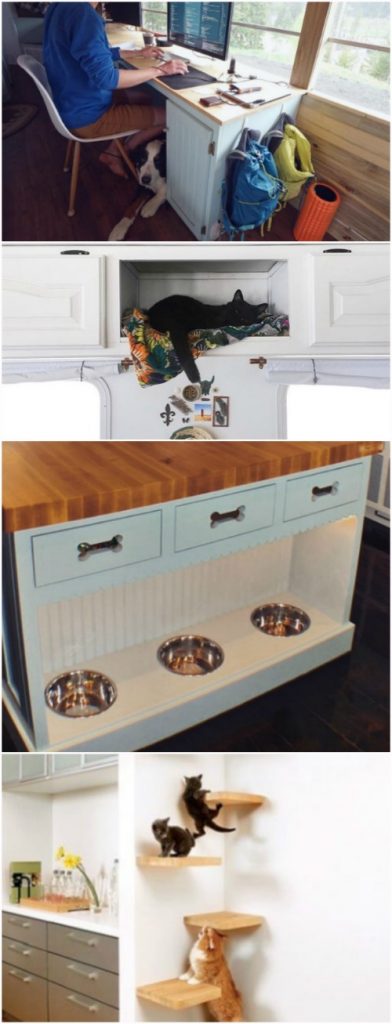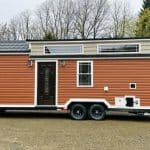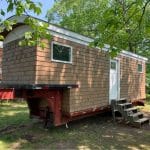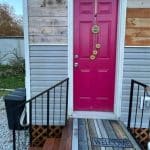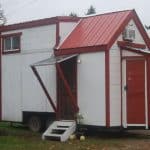Moving into a tiny house with a pet might sound easy. A lot of tiny house dwellers do live with a cat or a small dog—or sometimes even a big dog. But if you decide to take the plunge, you will discover that it is harder than advertised. There are a lot of logistical snags to deal with. Following are X tips to help you out!
Article Quick Links:
1. Put food and water bowls in recessed areas.
Image:
Food and water bowls for pets underfoot in a tiny home are problematic. They are easy to stumble over, and you certainly don’t want to constantly be cleaning up spills.
One of the best solutions I’ve seen is this kitchen counter which includes a recessed built-in spot for the bowls. Above them is a set of drawers for pet supplies. The bowls are kept out of the way and will not slide around on the floor. Nonetheless, they are easy for pets (and you) to reach.
So if you are going to be building or ordering custom furniture for your tiny house, consider incorporating a counter like this. An alternate idea might be to install a customized shelf near the base of a wall; it would not keep the bowls entirely out of the way, but it would keep them off the floor.
2. Skip carpeting.
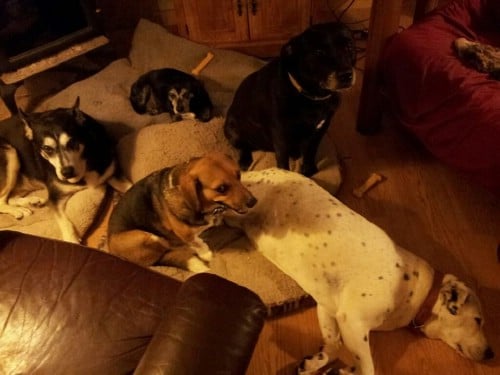
Whether this is a must or not depends on the pets you have. One small short-haired animal probably wouldn’t necessitate skipping out on carpeting. But if you have one or more long-haired or animals or you have a large dog bounding around, you will do better if you go with some kind of hard flooring. Choose a durable material like laminate which can stand up to lots of wear and tear and which is easy to clean.
3. Make creative use of spaces in your home to give your pet a cozy nook.
Image:
I’m not altogether sure how the cat in this image managed to get up to that little spot, but I imagine she can leap up from some surface which is just below the bottom of the photo. Regardless, she looks ridiculously comfy!
I live in a tiny house myself with a cat and my boyfriend. When we first adopted the cat, she was a stray, and we were at a loss for how to create a space for her to feel comfortable and safe. We thought about buying her a scratching post with a high perch, but there was nowhere to put it.
She turned out to be pretty creative, and quickly found two spots to call her own. The first is the dashboard up front (our tiny house is an RV).
The second was a surprise. We have a cabinet under our bathroom sink that the door broke off of. We were going to get it fixed, but never got around to it. It turns out she can squeeze through the open cabinet and crawl into a hidden space in the wall. She goes there whenever a loud truck drives by outside or the weather gets harsh. It is her safe spot.
So if you cannot think of how to create a nook for your pet in your tiny house, don’t fret—your pet might very well come up with a solution on her own!
4. Create a catwalk (literally).
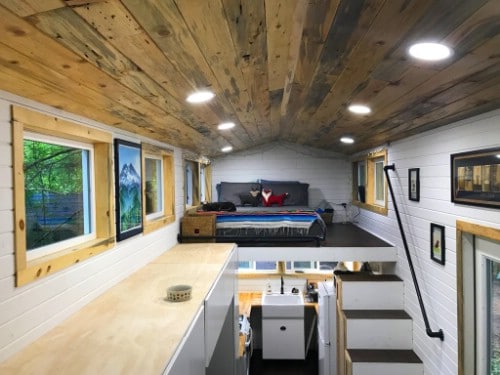
Here is another cool solution to creating a high, comfortable space for cats. On the left-hand side of this photo, you can see a “catwalk” which is actually the top of a set of storage cabinets. Since it is roughly level with the loft, cats can easily climb up the stairs to the loft, and then move from there to the catwalk. Even though it cannot support the weight of a human, it is just fine for felines.
5. Make sure you have plenty of windows.
Image:
Both dogs and cats love looking outdoors and smelling the fresh air. For some, this is enough to prevent them from wanting to run around outdoors. That is important with tiny house living, because there is a good chance you will not have your own fenced-in yard. You want your pets to stay indoors and safe whenever possible. So try and build or buy a tiny house that includes lots of big windows.
6. Walk dogs before you move your tiny home.
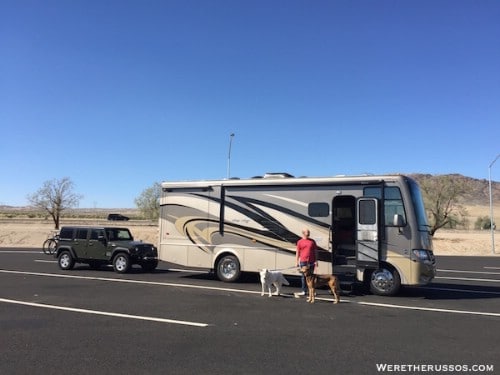
If you will regularly be moving your tiny home around, one thing you don’t need is antsy dogs running around while you are trying to get from point A to point B. A smart practice is to take your dogs out for a walk before you move your house. Make sure that they expend as much energy as possible so that they will be calm while you are on the move. Do the same thing when you reach rest stops. This is also a great chance for you to get a bit of fresh air, stretch your legs, and slow down to appreciate the scenery.
7. Add features to your home to entertain cats.
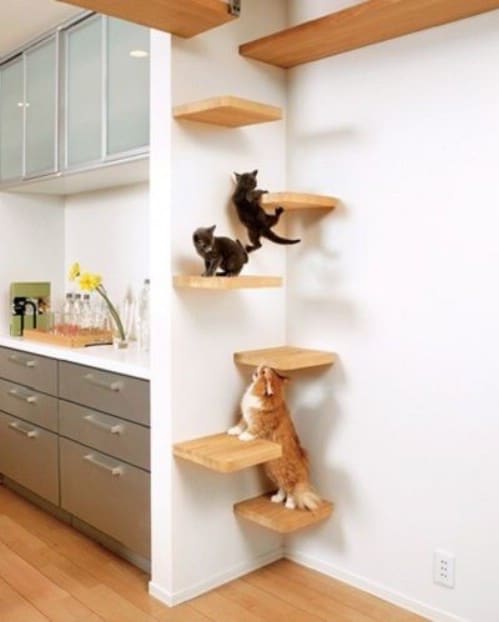
I can’t tell from this photo if these steps are only for cats, or if they are also intended for humans. Either way, it is clear that these kittens are having a blast! Steps like these are actually pretty common in tiny house layouts, even without pets in mind—so shop for features like this one when you pick out your tiny home.
Speaking of keeping your pets entertained, another challenge you might face keeping animals in a small space is that they will be sleeping near you at night. At least, you hope they will be sleeping; far too often, they will be bounding around waking you up because they are bored.
To prevent this, I recommend that you take time throughout the day to amuse them and tire them out. If you can schedule half an hour or so of play shortly before bedtime, there is a good chance you can settle them down for the night.
8. Get used to living in cramped quarters.
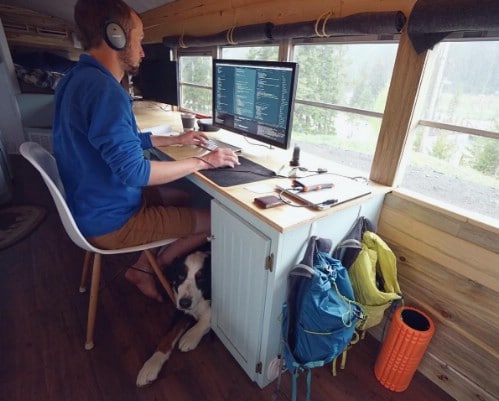
Living in a tiny space with pets means that quite frequently, your animals will be intruding on your space. This is one of those realities of tiny house living which you will simply need to adapt to. That might mean sharing the space under your desk with your dog or letting your cat curl up with you on the couch—even if there is almost no room to do it. Just remember that all good things in life require that you make adaptations.
9. You will need to get really creative with the litter box.
If you have a cat, one of the biggest challenges of tiny house living is going to be figuring out where your feline friend can do his business. Thankfully, there are a lot of ideas here:
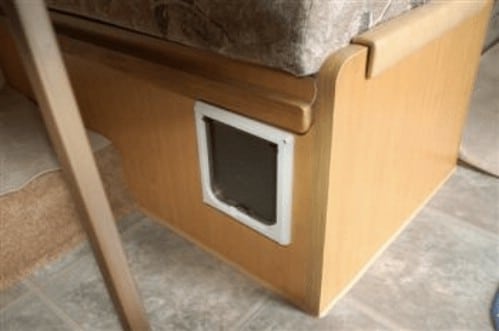
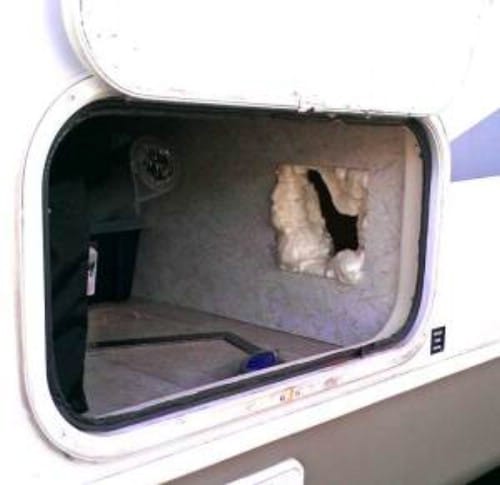
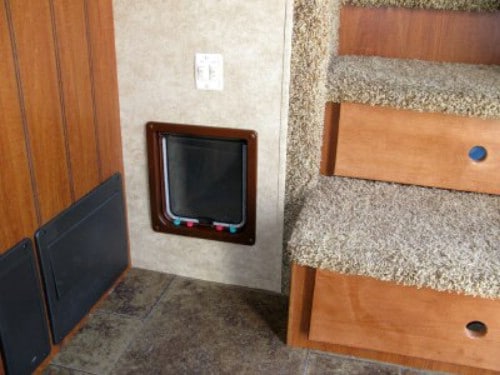
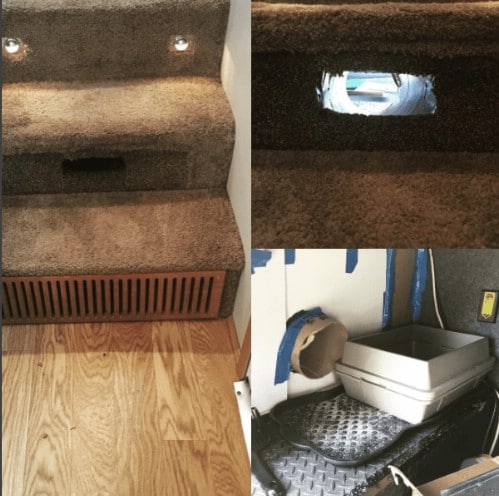
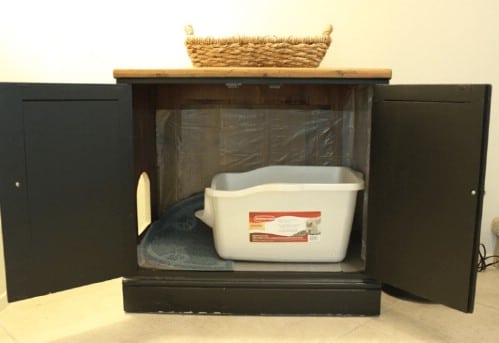
Conclusion: Living in a Tiny House With Pets Is Possible If You Are Clever and Willing to Adapt
You may think, “Tiny living is not for me; I have two large dogs.” But lots of tiny house owners have found a way to make it work, and you can too. It does mean you will have to make some changes to accommodate your pets, but if you are willing to put in the effort, it will be more than worth it!

